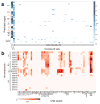Zebrafish behavioral profiling identifies multitarget antipsychotic-like compounds
- PMID: 27239787
- PMCID: PMC4912417
- DOI: 10.1038/nchembio.2097
Zebrafish behavioral profiling identifies multitarget antipsychotic-like compounds
Abstract
Many psychiatric drugs act on multiple targets and therefore require screening assays that encompass a wide target space. With sufficiently rich phenotyping and a large sampling of compounds, it should be possible to identify compounds with desired mechanisms of action on the basis of behavioral profiles alone. Although zebrafish (Danio rerio) behavior has been used to rapidly identify neuroactive compounds, it is not clear what types of behavioral assays would be necessary to identify multitarget compounds such as antipsychotics. Here we developed a battery of behavioral assays in larval zebrafish to determine whether behavioral profiles can provide sufficient phenotypic resolution to identify and classify psychiatric drugs. Using the antipsychotic drug haloperidol as a test case, we found that behavioral profiles of haloperidol-treated zebrafish could be used to identify previously uncharacterized compounds with desired antipsychotic-like activities and multitarget mechanisms of action.
Conflict of interest statement
AJR, DK and RTP declare competing financial interests in the form of a pending patent application, No. PCT/US2015/037755, covering the finazine compounds described in this manuscript. AV, TE, GC and DL are full time employees of Teleos Therapeutics. DK and RTP consult for Teleos Therapeutics. SK and EP are full time employees of F. Hoffmann – La Roche Ltd.
Figures





References
-
- Roth BL, Sheffler DJ, Kroeze WK. Magic shotguns versus magic bullets: selectively non-selective drugs for mood disorders and schizophrenia. Nat Rev Drug Discov. 2004;3:353–359. - PubMed
-
- Paul SM, et al. How to improve R&D productivity: the pharmaceutical industry’s grand challenge. Nat Rev Drug Discov. 2010;9:203–214. - PubMed
-
- López-Muñoz F, Alamo C. The consolidation of neuroleptic therapy: Janssen, the discovery of haloperidol and its introduction into clinical practice. Brain research bulletin. 2009;79:130–141. - PubMed
Publication types
MeSH terms
Substances
Grants and funding
LinkOut - more resources
Full Text Sources
Other Literature Sources

